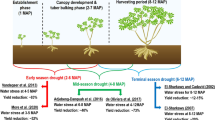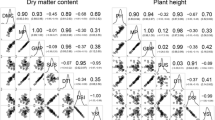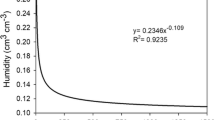Summary
Cassava (Manihot esculenta Crantz) is a staple food for a large sector of human population in the tropics. It is widely produced for its starchy roots by small farmers over a range of environments on poor infertile soils with virtually no inputs. It is highly productive under favorable conditions and produces reasonably well under adverse conditions where other crops fail. The crop, once established, cansurvive for several months without rain. There is a wide variation within the cassava germplasm for tolerance to prolonged drought and the possibility to breed and select for stable and relative high yields under favorable and adverse conditions does indeed exist. Research with several cassava clones at CIAT has shown that high root yield under mid—term stress is not incompatible with high yield under nonstress conditions. Plant types with high yield potential under both conditions (e.g. the hybrid CM 507-37) are characterized by having slightly higher than optimum leaf area index under nonstress conditions, higher leaf area ratio and more intensive and extensive fine root system.
Similar content being viewed by others
References
CIAT 1980 Cassava Program. Annual Report 1979, Centro Internacional de Agricultura Tropical, A.A. 6713, Cali, Colombia.
CIAT 1983 Cassava Program. Annual Report 1982-1983, Centro Internacional de Agricultura Tropical, A.A. 6713, Cali, Colombia.
CIAT 1985 Cassava Program. Annual Report 1984, Centro Internacional de Agricultura Tropical, A.A. 6713, Cali, Colombia.
Cock J H 1984 Cassava.In The Physiology of Tropical Field Crops. Eds. P R Goldsworthy and N M Fisher. pp 529–549. John Wiley & Sons Ltd.
Cock J H 1985 Cassava: New Potential for a Neglected Crop. Westview Press. Boulder, Colorado.
Connor D J, Cock J H and Parra G E 1981 The response of cassava to water shortage. I. Growth and Yield. Field Crop Res.4, 181–200.
De Sena Z F and Dos Campos R H 1973 Estudio do sistema radicular da mandioca (Manihot esculenta Crantz) submetidas a differentes frequencias de irrigacao. Univ. Fed. Bahia, Esc. Agron., Ser Pesqui. 1. BRASCAN Nordeste, Cruz das Almas, Brazil, pp 41–52.
Howeler R H 1985 Potassium Nutrition of Cassava.In Potassium in Agriculture. pp 819–841. ASA-CSSA-SSSA, South Segoe Road, Madison, WI 53711, USA.
IITA 1985 Research Highlights 1984 International Institute of Tropical Agriculture, PMB 5320, Oyo Road, Ibadan, Oyo State, Nigeria.
Jones W O 1959 Manioc in Africa. Stanford University Press, Stanford.
Lancaster P A and Brooks J E 1983 Cassava leaves as human food. Economic Botany 37(3), 331–348.
Leihner D 1983 Management and Evaluation of Intercropping Systems with Cassava. Centro Internacional de Agricultura Tropical, A.A. 6713, Cali, Colombia.
Lesczynski D B and Tanner C B 1976 Seasonal variation of root distribution of irrigated, field grown Russet Burbank Potato. Am. Potato J. 53, 69–78.
Nair P K R 1983 Agroforestry with coconuts and other tropical plantation crops. pp 79–102.In Plant Research and Agroforestry. Ed. P A Huxley, International Council for Research in Agroforestry, Nairobi, Kenya.
Taylor H M and Klepper B 1978 The role of rooting characteristics in the supply of water to plants. Adv. Agron. 30, 99–128.
Wholey D W 1974 Rapid Propagation of Cassava, PhD Thesis, University of the West Indies, St. Augustine, Trinidad.
Willatt S T and Taylor H M 1978 Water uptake by soya-bean roots as affected by their depth and by soil water content. J. Agric. Sci., Camb. 90, 205–213.
Author information
Authors and Affiliations
Rights and permissions
About this article
Cite this article
El-Sharkawy, M.A., Cock, J.H. Response of cassava to water stress. Plant Soil 100, 345–360 (1987). https://doi.org/10.1007/BF02370950
Issue Date:
DOI: https://doi.org/10.1007/BF02370950




